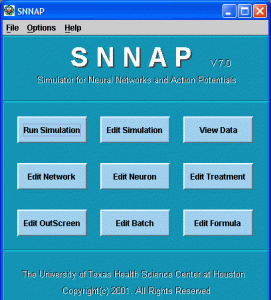Simulator for Neural Networks and Action Potentials (SNNAP)

SNNAP Software Home Screen.
SNNAP是快速开发的工具吗lopment and simulation of realistic models of single neurons and neural networks. It includes mathematical descriptions of ion currents and intracellular second messengers and ions. In addition, you can simulate current flow in multicompartment models of neurons by using the equations describing electric coupling.
SNNAP also includes mathematical descriptions of intracellular second messengers and ions, and simulate the modulation of membrane currents and synaptic transmission, either enhancement or inhibition.
Other advantages of SNNAP include:
- Written in JAVA and can run on virtually any type of computer system.
- Graphical user interface
- Ability to simulate common experimental manipulations.
- Modular organizations of input files.
SNNAP development has been supported by AFOSR grant F49620-93-1-0272, as well as NIH grants R01-RR11626 and P01-NS38310.
SNNAP Overview
SNNAP被设计为用于快速开发和模拟单神经元和小神经网络的现实模型的工具。单个神经元的电性能用霍奇金 - 赫克斯利型电压和时间依赖的离子电流描述。神经元之间的连接可以通过电气突触或化学突触进行。化学突触连接能够表达几种形式的可塑性,例如同性突触和异质性抑郁症和促进。
SNNAPalso includes mathematical descriptions of intracellular second messengers and ions. The synthesis of second messengers can be driven by either synaptic inputs or by externally applied transmitters. The accumulation of an ion can be driven by any specified voltage- and time- dependent ionic current(s). The intracellular concentrations of ions and/or second messengers, in turn, can be linked to one or more ionic conductances and/or mechanisms contributing to chemical synaptic transmission. Thus, SNNAP can simulate the modulation, either enhancement or inhibition, of membrane currents and synaptic transmission.
SNNAPalso can simulate current flow in multicompartment models of neurons by using the equations describing electrical coupling. [For specific details of the mathematical components of SNNAP, see Ziv,Baxter and Byrne (1994) Simulator for Neural Networks and Action Potentials: Description and Application. J. Neurophysiol. 71: 294-308.]
Some of the advantages of SNNAP include:
- A graphical user interface (GUI).
All aspects of specifying the intrinsic properties of a neuron, the structure of a network, and properties of running a simulation, such as visual displays and saving the data to files, can be controlled via editors incorporated into SNNAP that use graphical interfaces. Thus, little or no programming skills are necessary to use the simulator. - The ability to simulate common experimental manipulations.
For example, SNNAP can simulate injection of external currents into multiple cells, removal of individual conductances to simulate pharmacological agents, modulation of membrane currents via application of modulatory transmitters and voltage-clamping cells. - The modular organization of input files.
All equations and associated parameters and constants are passed to SNNAP through a number of files generated by the graphical editors. The hierarchical organization of these input files allows for the creation of a library of modules describing different aspects of neural networks (such as descriptions of various voltage-dependent conductances, neurons, synaptic connections or modulatory actions), thereby facilitating the creation of new neurons or networks from preexisting elements and the exchange of files among collaborators.